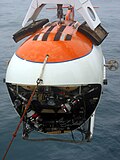Underwater acoustic positioning system
Underwater Acoustic Positioning System[edit]
An underwater acoustic positioning system is a technology used to determine the position of an object underwater. These systems are commonly used in oceanography, marine biology, and underwater archaeology to track the location of submersibles, divers, and other underwater equipment.
Types of Systems[edit]
There are several types of underwater acoustic positioning systems, each with its own method of operation and application:
Long Baseline (LBL) Systems[edit]

LBL systems use a network of transponders placed on the seafloor. The position of an object is determined by measuring the time it takes for a signal to travel between the object and the transponders. This method provides high accuracy and is often used for ROV operations and submarine tracking.
Short Baseline (SBL) Systems[edit]
SBL systems use a set of transducers mounted on a vessel. The position of an object is calculated by measuring the time difference of arrival of signals at the different transducers. SBL systems are typically used for diver tracking and AUV operations.
Ultra-Short Baseline (USBL) Systems[edit]
USBL systems combine the features of LBL and SBL systems. They use a single transducer to send and receive signals, and the position is determined by measuring the angle and time of arrival of the signal. USBL systems are versatile and can be used for a variety of applications, including oceanographic research and marine construction.
Applications[edit]
Underwater acoustic positioning systems are used in a wide range of applications:
- Scientific Research: Used in oceanography to track the movement of ocean currents and marine life.
- Marine Construction: Essential for the precise placement of underwater structures such as oil rigs and cables.
- Search and Recovery: Used in salvage operations to locate and recover objects from the seafloor.
Historical Development[edit]

The development of underwater acoustic positioning systems began in the mid-20th century, driven by the need for accurate underwater navigation. Early systems were developed for military applications, such as tracking submarines. Over time, the technology has evolved and expanded into commercial and scientific fields.
Notable Uses[edit]

- The Bathyscaphe Trieste used acoustic positioning during its historic dive to the Challenger Deep in 1960.
- The Mir submersibles have used advanced acoustic positioning systems for deep-sea exploration.

Future Developments[edit]
Advancements in acoustic technology and signal processing continue to improve the accuracy and reliability of underwater positioning systems. Future developments may include integration with satellite navigation systems and enhanced data transmission capabilities.
Related Pages[edit]
Underwater_acoustic_positioning_system[edit]
-
LBL Acoustic Positioning Aquamap ROV
-
USNS Mizar
-
Bathyscaphe Trieste
-
Mir front
-
NetTrack Operation
Ad. Transform your life with W8MD's Budget GLP-1 injections from $75


W8MD offers a medical weight loss program to lose weight in Philadelphia. Our physician-supervised medical weight loss provides:
- Weight loss injections in NYC (generic and brand names):
- Zepbound / Mounjaro, Wegovy / Ozempic, Saxenda
- Most insurances accepted or discounted self-pay rates. We will obtain insurance prior authorizations if needed.
- Generic GLP1 weight loss injections from $75 for the starting dose.
- Also offer prescription weight loss medications including Phentermine, Qsymia, Diethylpropion, Contrave etc.
NYC weight loss doctor appointmentsNYC weight loss doctor appointments
Start your NYC weight loss journey today at our NYC medical weight loss and Philadelphia medical weight loss clinics.
- Call 718-946-5500 to lose weight in NYC or for medical weight loss in Philadelphia 215-676-2334.
- Tags:NYC medical weight loss, Philadelphia lose weight Zepbound NYC, Budget GLP1 weight loss injections, Wegovy Philadelphia, Wegovy NYC, Philadelphia medical weight loss, Brookly weight loss and Wegovy NYC
|
WikiMD's Wellness Encyclopedia |
| Let Food Be Thy Medicine Medicine Thy Food - Hippocrates |
Medical Disclaimer: WikiMD is not a substitute for professional medical advice. The information on WikiMD is provided as an information resource only, may be incorrect, outdated or misleading, and is not to be used or relied on for any diagnostic or treatment purposes. Please consult your health care provider before making any healthcare decisions or for guidance about a specific medical condition. WikiMD expressly disclaims responsibility, and shall have no liability, for any damages, loss, injury, or liability whatsoever suffered as a result of your reliance on the information contained in this site. By visiting this site you agree to the foregoing terms and conditions, which may from time to time be changed or supplemented by WikiMD. If you do not agree to the foregoing terms and conditions, you should not enter or use this site. See full disclaimer.
Credits:Most images are courtesy of Wikimedia commons, and templates, categories Wikipedia, licensed under CC BY SA or similar.
Translate this page: - East Asian
中文,
日本,
한국어,
South Asian
हिन्दी,
தமிழ்,
తెలుగు,
Urdu,
ಕನ್ನಡ,
Southeast Asian
Indonesian,
Vietnamese,
Thai,
မြန်မာဘာသာ,
বাংলা
European
español,
Deutsch,
français,
Greek,
português do Brasil,
polski,
română,
русский,
Nederlands,
norsk,
svenska,
suomi,
Italian
Middle Eastern & African
عربى,
Turkish,
Persian,
Hebrew,
Afrikaans,
isiZulu,
Kiswahili,
Other
Bulgarian,
Hungarian,
Czech,
Swedish,
മലയാളം,
मराठी,
ਪੰਜਾਬੀ,
ગુજરાતી,
Portuguese,
Ukrainian



